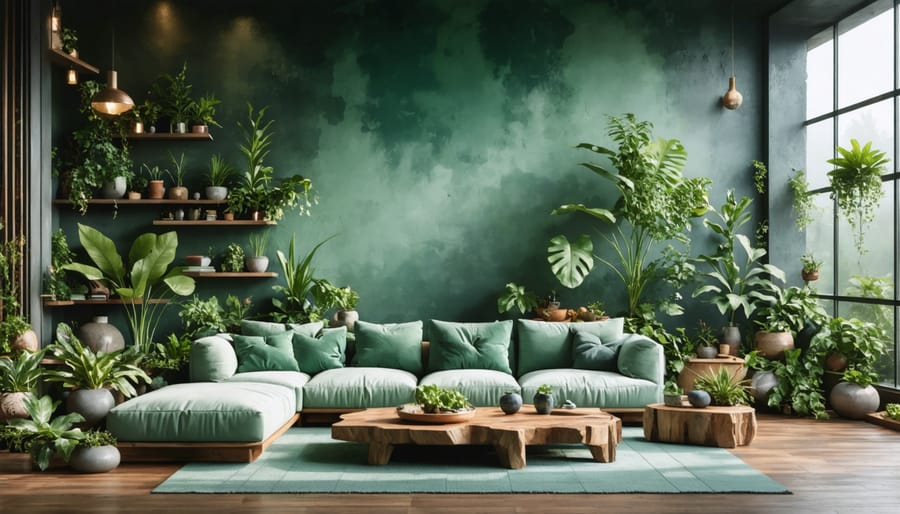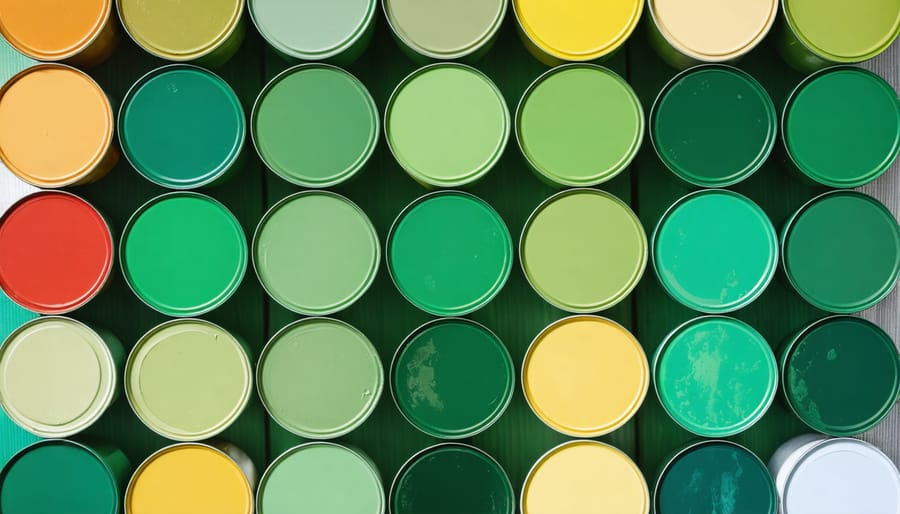
Transform Your Home with Earth-Friendly Paint (That Actually Looks Amazing)
Transform your living space into a healthier, more sustainable environment with eco-friendly paint choices that protect both your family and the planet. Today’s sustainable paints offer remarkable durability and stunning finishes while eliminating harmful volatile organic compounds (VOCs) that traditionally make painting projects hazardous. These innovative formulations harness natural ingredients like clay, milk protein, and plant-based oils to deliver rich, lasting color without compromising indoor air quality.
As homeowners increasingly prioritize environmental responsibility, sustainable paint has evolved from a niche product to a mainstream solution that rivals conventional options in performance and style. Leading manufacturers now offer zero-VOC options in thousands of colors, making it easier than ever to achieve designer results while maintaining eco-conscious standards. Whether you’re refreshing a single room or tackling a whole-house makeover, choosing sustainable paint represents a simple yet powerful step toward creating a more environmentally responsible home.
Beyond the immediate benefits to your living space, sustainable paint contributes to broader environmental goals by reducing chemical waste, supporting renewable resources, and minimizing carbon footprint throughout the manufacturing process. The best part? These earth-friendly options often provide superior coverage and longevity, making them a smart investment for both your home and the environment.
What Makes Paint Sustainable?
Low and Zero VOC Formulations
Volatile Organic Compounds (VOCs) are harmful chemicals traditionally found in paint that evaporate into the air as the paint dries. These compounds can cause headaches, respiratory issues, and other health problems, while also contributing to air pollution and environmental damage. The good news is that modern sustainable paint manufacturers have developed excellent low and zero VOC alternatives that perform just as well as conventional paints.
Low VOC paints contain less than 50 grams per liter of volatile compounds, while zero VOC options have less than 5 grams per liter. These environmentally conscious formulations maintain high quality and durability while significantly reducing indoor air pollution. They’re especially beneficial for people with allergies, asthma, or chemical sensitivities, and they’re perfect for painting children’s rooms and other sensitive spaces.
When choosing low or zero VOC paint, look for third-party certifications like Green Seal or GREENGUARD. These paints typically have minimal odor, allowing you to occupy freshly painted rooms sooner. While they might cost slightly more upfront, the health and environmental benefits make them a worthwhile investment for your home and family.

Natural and Recycled Ingredients
Today’s sustainable paints are revolutionizing the industry by incorporating sustainable materials and natural ingredients that minimize environmental impact without compromising quality. Common natural ingredients include clay, milk protein, citrus peel extracts, and plant-based oils, which replace traditional petroleum-based components. These eco-friendly alternatives not only reduce toxic emissions but also create healthier indoor air quality.
Many manufacturers now use recycled content in their paint production, such as reclaimed water, post-consumer plastics for packaging, and even recycled paint collected through take-back programs. The process involves filtering and treating old paint to create new, high-quality products. Some brands incorporate innovative materials like agricultural waste products and mineral-based pigments that require less processing.
Water-based formulations have largely replaced solvent-based options, significantly reducing VOC emissions during both manufacturing and application. The latest innovations include biodegradable additives and natural preservatives derived from plant extracts, ensuring the paint remains durable while maintaining its eco-friendly properties.
Sustainable Paint Application Techniques
Proper Surface Preparation
Proper surface preparation is crucial for achieving long-lasting, eco-friendly finishes that truly stand the test of time. Start by thoroughly cleaning the surface using natural, biodegradable cleaners like vinegar and water solutions or citrus-based degreasers. These alternatives are just as effective as harsh chemical cleaners but safer for both you and the environment.
For walls with existing paint, gently sand the surface using recycled sandpaper or biodegradable sanding blocks. Remember to wear a mask and collect dust using a vacuum with a HEPA filter to prevent particles from entering the air or water systems. If you encounter mold, treat it with a mixture of water and tea tree oil or vinegar instead of chemical-based solutions.
Fill any holes or cracks with natural putty or eco-friendly spackling compounds made from minerals and plant-based materials. These products work just as effectively as conventional fillers while maintaining your commitment to sustainability. Allow proper drying time between steps, and ensure good ventilation throughout the process.
Before applying your sustainable paint, wipe down the surface one final time with a damp, lint-free cloth made from natural fibers. This removes any remaining dust and creates the perfect canvas for your environmentally conscious paint job.

Efficient Application Methods
Getting the most out of your sustainable paint starts with smart application techniques. Begin by carefully measuring your space and calculating the exact amount of paint needed – this prevents waste and saves money. A paint calculator app can help you determine precise quantities for your project.
Before you start, prepare your surfaces thoroughly. Clean walls and proper priming not only improve paint adhesion but also reduce the number of coats needed. When painting, use the W-technique: paint in a W pattern about 3-4 feet wide, then fill in the spaces without lifting your roller. This method ensures even coverage and minimizes overlap.
Choose high-quality rollers and brushes specifically designed for your paint type. While they might cost more initially, they hold more paint and provide better coverage, reducing waste and improving efficiency. For detailed work, use appropriately sized brushes to avoid excess paint application.
Consider using a paint sprayer for large areas – they can provide more even coverage with less paint waste when used correctly. Just be sure to protect surrounding areas well and practice your technique first.
Store leftover paint properly by sealing the can tightly and storing it upside down. This creates an airtight seal that keeps the paint fresh for touch-ups, reducing the need to buy new paint for small jobs. For tiny touch-ups, transfer small amounts to airtight containers instead of opening the main can repeatedly.

Top Sustainable Paint Brands and Products
When it comes to eco-friendly paint options, several brands stand out for their commitment to sustainability and quality. Benjamin Moore’s Natura line leads the pack with zero VOC emissions and asthma & allergy-friendly certification. Their paints come in a wide range of colors and finishes, making them perfect for any room in your home.
ECOS Paints has earned recognition for their completely non-toxic formulations. Their water-based paints are free from harmful chemicals and ideal for sensitive environments like nurseries and hospitals. They offer excellent coverage and durability while maintaining high environmental standards.
Sherwin-Williams’ Harmony collection deserves mention for its innovative air-purifying technology. These paints actually help reduce indoor air pollutants, making your space healthier while looking beautiful. The collection features a zero VOC formula and outstanding coverage properties.
Clare Paint has revolutionized the sustainable paint market with their direct-to-consumer approach. Their curated color selection and user-friendly ordering process make choosing the right shade a breeze. All their paints are zero VOC and come in recyclable packaging.
AFM Safecoat stands out for their specialized formulations designed for chemically sensitive individuals. Their products are rigorously tested and perfect for those seeking the purest possible paint options.
For budget-conscious consumers, Behr’s Premium Plus line offers an excellent balance of affordability and eco-friendliness. These zero VOC paints provide great coverage and durability without breaking the bank.
Real Milk Paint Co. offers a unique option for those seeking traditional, all-natural finishes. Their milk-based paints are completely biodegradable and safe enough to compost. While best suited for specific applications like furniture and craft projects, they provide an authentically sustainable choice.
Each of these brands has been third-party tested for environmental claims and performance, ensuring you can trust their sustainable credentials while achieving beautiful results in your space.
Cost Considerations and Long-term Benefits
Price Comparison
When comparing costs, sustainable paints typically range from $45 to $65 per gallon, while conventional paints average between $25 to $45 per gallon. While this price difference might seem significant at first glance, it’s important to consider the long-term value. Sustainable paints often offer better coverage, requiring fewer coats and less product overall. A typical room might need 2-3 gallons of conventional paint but only 1-2 gallons of sustainable paint.
Additionally, sustainable paints tend to be more durable and maintain their finish longer, potentially saving money on repainting costs down the line. Many eco-friendly paints also eliminate the need for primers, which can save an additional $20-30 per gallon in material costs.
For a standard 12×12 room, here’s the typical cost breakdown:
– Conventional Paint: $75-135 (including primer)
– Sustainable Paint: $90-130 (often no primer needed)
When factoring in the reduced need for touch-ups and longer lifespan, sustainable paints often prove to be the more cost-effective choice over time, despite the higher initial investment.
Health and Environmental Savings
Choosing sustainable paint isn’t just good for the planet – it’s a smart investment that pays off in multiple ways. Unlike conventional paints, eco-friendly options typically contain fewer volatile organic compounds (VOCs), resulting in better indoor air quality for you and your family. This reduction in harmful chemicals means fewer headaches, respiratory issues, and allergic reactions, potentially leading to lower healthcare costs over time.
Beyond health benefits, sustainable paints contribute to overall energy efficiency as one of many sustainable home features. Many eco-friendly paints offer better coverage and durability, requiring fewer coats and less frequent repainting. This translates to significant cost savings on materials and labor over the years.
Additionally, homes featuring sustainable materials often command higher resale values, as environmentally conscious features become increasingly important to buyers. The long-term environmental impact is equally impressive – sustainable paints reduce landfill waste, lower carbon emissions during production, and minimize water pollution, helping preserve our ecosystem for future generations while keeping your renovation costs in check.
DIY Maintenance Tips
Maintaining your sustainable paint finish doesn’t have to be complicated. With regular care and attention, you can extend the life of your eco-friendly paint job and keep it looking fresh for years to come. Here are some proven maintenance tips that are both effective and environmentally conscious.
Start with regular dusting using a microfiber cloth or duster to prevent dirt buildup. For routine cleaning, mix a gentle solution of warm water with a few drops of plant-based dish soap. Avoid harsh chemical cleaners that can damage the paint and release harmful compounds into your home.
When dealing with marks or stains, spot-clean using a soft, damp cloth. Work gently from the outside of the stain toward the center to prevent spreading. For stubborn spots, try a mixture of baking soda and water to create a mild, natural cleaning paste.
Monitor your walls for signs of moisture damage, particularly in bathrooms and kitchens. Good ventilation is crucial – use exhaust fans and open windows regularly to prevent humidity buildup that can affect paint longevity.
Keep touch-up paint properly stored in an airtight container in a cool, dry place. Before using stored paint, stir it thoroughly rather than shaking to prevent air bubbles. When touching up, feather the edges of the painted area to blend seamlessly with the existing finish.
For exterior sustainable paint, conduct seasonal inspections for peeling or damage. Address any issues promptly to prevent further deterioration. Clean exterior surfaces annually using a garden hose and soft brush – avoid pressure washers that might damage the paint film.
Remember to document the paint brand, color code, and finish type for future reference. This information will be invaluable for touch-ups and maintaining consistency in your sustainable painting projects.
As we’ve explored throughout this article, sustainable paint represents more than just an eco-friendly choice – it’s a smart investment in our homes and our planet’s future. By choosing low-VOC or zero-VOC paints, you’re creating healthier indoor spaces while reducing environmental impact. These modern sustainable options now offer the same beautiful finishes and durability as traditional paints, proving that you don’t have to compromise on quality to make environmentally conscious decisions.
Remember that sustainable painting goes beyond just product selection. Proper planning, careful application, and smart disposal practices all contribute to a more environmentally responsible approach. By calculating your needs accurately, you’ll minimize waste and save money while protecting our environment.
The shift toward sustainable paint is gaining momentum, with more manufacturers developing innovative eco-friendly solutions. As consumers, we have the power to drive positive change through our choices. Whether you’re planning a small room refresh or a complete home makeover, consider making sustainable paint your go-to option.
Start small if you’re new to eco-friendly painting – perhaps with a bedroom or home office – and experience the benefits firsthand. You’ll quickly discover that sustainable paint delivers excellent coverage, beautiful results, and the peace of mind that comes from making environmentally responsible choices. Your walls, your health, and our planet will thank you for making the switch to sustainable paint solutions.
